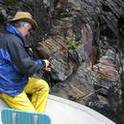Article
The Red Bed Controversy Revisted: Shape Analysis of Colorado Plateau Units Suggests Long Magnetization Times
Tectonophysics
(2003)
Abstract
Several Triassic and earliest Jurassic sedimentary units from the Colorado Plateau region have distributions of virtual geomagnetic poles (VGPs) that are highly elongate along the path of apparent polar wander (APW). This suggests that the remanent magnetizations measured in these units were acquired over an extended period of time, possibly approaching 35 m.y., and are not precisely coeval with the stratigraphic age of the rock. Comparison with other paleomagnetic studies shows that the observed elongation is not a general attribute of the age of the rock, nor is it related to paleolatitude. The rocks that yield elongate VGP distributions are dominantly red to brown mudstones, and it is possible that their remanence is dominated by a slowly acquired chemical remanent magnetization, as suggested by Larson et al. [J. Geophys. Res. 87 (1982) 1081] and other authors. However, several superficially similar units from the Colorado Plateau have nearly circular VGP distributions. The process by which remanence is acquired in clastic sedimentary rocks merits further study.
Keywords
- Red bed controversy,
- Shape analysis,
- Colorado Plateau
Disciplines
Publication Date
February, 2003
Citation Information
Bernard A. Housen, Myrl E. Beck and Russell F. Burmester. "The Red Bed Controversy Revisted: Shape Analysis of Colorado Plateau Units Suggests Long Magnetization Times" Tectonophysics Vol. 362 Iss. 1-4 (2003) Available at: http://works.bepress.com/russ_burmester/14/
